The Hard Right in 2025: What the Latest SPLC Report Reveals About Extremism, Disinformation, and Repair
From violent accelerationism to Confederate nostalgia, the far right is evolving, and so must our collective response.
The Southern Poverty Law Centre’s October 2025 Intelligence Project Dispatch paints a sobering picture of the hard right in the United States. The report chronicles a movement that is increasingly fragmented yet deeply interconnected, one that ranges from white nationalist street fighters to anti-government ideologues, misogynist influencers, and elected officials echoing extremist talking points.
At first glance, it reads like a catalogue of hate. But beneath that surface, the dispatch shows how cultural isolation, political polarisation, and algorithmic amplification are creating fertile ground for radicalisation. Understanding these forces is essential for anyone working in mental health, education, or community safety.
A snapshot of the current landscape
In August, members of the white nationalist Active Clubs network, alongside groups like Patriot Front and neo-Nazi bands, gathered in Southern California for their annual combat-sport event called Frontier. The meetup, verified by investigative outlet Bellingcat, shows how modern extremist movements are merging fitness, violence, and social media aesthetics to recruit and train.
Only weeks later, 24-year-old Skyler Philippi pleaded guilty to plotting to bomb electrical substations in Tennessee, telling an undercover agent he wanted to trigger chaos in the United States. Philippi described himself as an accelerationist, part of an ideology that celebrates societal collapse as a path towards authoritarian rebirth.
These incidents illustrate the current extremist formula: a blend of online community, offline violence, and deep disaffection.
The gendered side of extremism
SPLC highlights an alarming statistic from the National Center for Missing and Exploited Children: 84 per cent of the victims of nihilistic violent extremist groups are female. This underscores a growing trend within radical networks that channel misogyny into ideology.
Researcher Cynthia Miller-Idriss, in her book Man Up: The New Misogyny and the Rise of Violent Extremism, connects this rise to a crisis of belonging. She notes that young people are increasingly isolated online, and that this isolation is spilling into real-world violence.
In response, SPLC and American University’s PERIL lab have released Not Just a Joke: Understanding and Preventing Gender- and Sexuality-Based Bigotry, a guide that helps parents and educators open conversations about online radicalisation. The resource emphasises that prevention starts long before violence, in small acts of engagement, empathy, and digital literacy.
From school boards to state houses: mainstreaming extremism
The dispatch shows how extremist ideas are no longer confined to underground spaces. In local governments and cultural institutions, fringe ideologies are increasingly finding legitimacy.
In California, a Moms for Liberty chapter chair made headlines for stripping to a bikini during a school board meeting to protest gender-inclusive locker room policies. In Maine, a county coordinator for the anti-government group Tactical Civics is now running for state office. Across the country, far-right networks are moving from street demonstrations into civic spaces, reframing anti-LGBTQ+, anti-immigrant, and anti-government narratives as freedom issues.
Even at the federal level, the U.S. Department of Education’s new America 250 Civics Education Coalition includes groups such as PragerU, Turning Point USA, and the Alliance Defending Freedom, organisations long criticised for spreading disinformation and hostility towards marginalised communities.
The return of Confederate nostalgia
The SPLC report also tracks how Lost Cause mythology continues to mutate. In September, the Trump administration ordered national parks to remove interpretive signage about slavery, including the famous “Scourged Back” photograph of Peter Gordon, a man who escaped enslavement. The removal, officials said, was necessary to keep displays in compliance with federal guidance, a phrase that in this case meant erasing historical truth.
At the same time, Confederate memorials removed from public spaces in Texas are being reinstalled in private parks under the banner of heritage preservation. These acts of revisionism are not symbolic; they are structural. They aim to reshape the narrative of U.S. history in ways that normalise white supremacy and minimise resistance.
Repair and prevention
The SPLC’s Intelligence Project reminds us that prevention is as much about relationship as it is about regulation. Extremism thrives in isolation, in the loneliness of disaffected young men, in online echo chambers that reward outrage, and in communities where inequality fuels resentment.
Prevention work must therefore extend beyond surveillance and policing. It includes creating spaces for young people to talk about what they see online, supporting educators who teach digital and emotional literacy, and funding trauma-informed community programmes that counter shame with belonging.
For practitioners, this means moving beyond pathology and towards understanding radicalisation as a relational and systemic process. Therapists, social workers, and educators all have a role in strengthening community resilience and fostering critical awareness.
The broader lesson
The far right is adapting to modern life faster than most institutions are responding to it. Its ideas travel through music, memes, wellness influencers, and freedom rhetoric that masks exclusionary agendas. Countering it requires more than outrage; it requires care, analysis, and coordinated public action.
At PTC, we endorse the SPLC’s ongoing work to document, research, and counter violent extremism. Their analysis provides essential insight into the social conditions that allow radical movements to grow, and the prevention tools that can help communities stay safe, informed, and connected. The path forward lies in collaboration between researchers, practitioners, and communities to build a culture that prioritises justice, truth, and belonging over division and fear.
Reference:
Southern Poverty Law Centre (2025, October 30). October 2025 Intelligence Project Dispatch: Trends and Incidents of the Hard Right.

